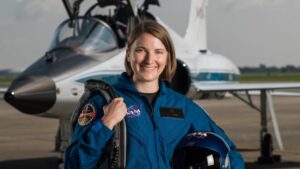NASA adds astronaut to commercial crew mission
By Jeff Foust

WASHINGTON — NASA announced May 17 it has assigned another astronaut to the next commercial crew mission to the International Space Station, a sign that NASA no longer expects to complete a seat barter agreement with Roscosmos in time for that flight.
NASA said that Kayla Barron will join the Crew-3 mission, launching on a SpaceX Crew Dragon spacecraft scheduled for launch no earlier than Oct. 23. Barron joins NASA astronauts Raja Chari and Tom Marshburn, and European Space Agency astronaut Matthias Maurer, who had been assigned to Crew-3 last December.
The Crew-3 mission will relieve the Crew-2 astronauts who arrived at the station on another Crew Dragon spacecraft April 24. The four Crew-3 astronauts will remain on the station for a six-month stay.
Barron, like Chari and Maurer, is a rookie astronaut. A naval officer, she was selected in the 2017 NASA astronaut class, which also included Chari. Marshburn, by contrast, will be making his third flight to space, having flown on the STS-127 shuttle mission in 2009 and later spending five months on the ISS as part of the Expedition 34/35 crew in 2012–2013.
Barron’s addition to the crew was not a surprise. Images of the SpaceX crew patch for the mission, posted on the website collectSPACE May 3, showed Barron’s name along with the three other astronauts previously assigned to the mission. A biography of Barron on the agency’s website also briefly stated around that time that she had been assigned to Crew-3.
NASA had kept the fourth seat on Crew-3 open for months in the hopes that it could be assigned to a Russian cosmonaut as part of a seat barter agreement. Under such an agreement, NASA astronauts would continue to fly on Soyuz seats in exchange for Roscosmos cosmonauts flying on commercial crew vehicles. Such “mixed crews” would ensure there is always at least one cosmonaut and one astronaut on the station at any time should either Soyuz or commercial crew vehicles be unavailable for an extended period.
By April, though, it appeared unlikely that an agreement between NASA and Roscosmos could be concluded in time for a cosmonaut to be assigned to and train for Crew-3. “We haven’t completely given up on having a cosmonaut on Crew-3, but at this point, given the schedule, it would be really, really challenging to complete all the training and get the suit fitted and done for a cosmonaut on Crew-3,” Steve Jurczyk, at the time NASA acting administrator, said at an April 21 briefing at the Kennedy Space Center ahead of the Crew-2 launch.
One factor that reduces the urgency for completing a seat barter agreement is Russia’s plans for upcoming Soyuz flights. NASA astronaut Mark Vande Hei, who flew to the station in April on a Soyuz spacecraft using a seat acquired through a third party, Axiom Space, would ordinarily return home in October. However, Roscosmos will fly a film director and actress to the station on the next Soyuz mission in October, the agency confirmed May 13, which means that Vande Hei and Russian cosmonaut Pyotr Dubrov will remain on the station, perhaps until April 2022.
“We’ll work through whether there’s an opportunity for Mark to extend to a year, or if we need to do something else to ensure that we have crew” on the U.S. segment of the station, Jurczyk said at that briefing.
May 18, 2021 at 08:16AM
via SpaceNews read more...

Post a Comment